Blowgun
A blowgun (also called a blowpipe or blow tube) is a simple ranged weapon consisting of a long narrow tube for shooting light projectiles such as darts. It operates by having the projectile placed inside the pipe and using the force created by one's forced exhalation ("blow") to pneumatically propel the projectile. The propulsive power is limited by the strength of the user's respiratory muscles and the vital capacity of their lungs.
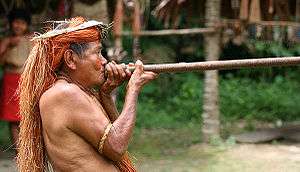
History
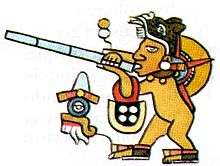
Many cultures have used this weapon, but various indigenous peoples of Southeast Asia, the Amazon and Guiana regions of South America, Western Europe and Guatemala in Central America are best known for its use.
Projectiles include seeds, clay pellets, and darts. Some cultures dip the tip of the darts in curare or other arrow poisons in order to paralyze the target. Blowguns were very rarely used by these tribes as anti-personnel weapons, but primarily to hunt small animals such as monkeys and birds. North American Cherokees were known for making blowguns from river cane to supplement their diet with rabbits and other small creatures.
Blowguns are depicted in paintings on pre-Columbian pottery and are mentioned in many Mesoamerican myths. Back then and today, the Maya use a blowgun to hunt birds and small animals with spherical dry seeds and clay pellets. The clay ammunition is made slightly larger than needed (to allow for shrinkage and refinement) and stored in a shoulderbag. The outside of the dry clay pellet is shaved off and burnished right before use.[1]
Shorter blowguns and smaller bore darts were used for varmint hunting by pre-adolescent boys in traditional Cherokee villages.[2] They used the blowguns to cut down on small rodents such as rats, mice, chipmunks and other mammals that cut or gnaw into food caches, seed and vegetable stores, or that are attracted to the planted vegetables. While this custom gave the boys something to do around the village and kept them out of mischief,[3] it also worked as an early form of pest control.[4] Some food was also obtained by the boys, who hunted squirrels with blowguns well into the 20th century.[5]
Today blowguns are used with tranquilizer darts to capture wildlife or to stun caged dangerous animals. Herpetologists use blowguns to capture elusive lizards with stun darts. Blowguns are also used recreationally, with either darts or paintballs.
Sport blowgun
There are several competition styles practised around the world. A standardization of competition style, based upon fukiya, is being pursued by the International Fukiyado Association and hopes to become an Olympic event. It is a 10-metre (33 ft) target shooting, using a standardized length 120 cm or 48 inch, and barrel calibera dart shape length and weight are free. Each round the shooter shoots 5 darts, there are 6 rounds per game, for a total of 30 darts. Target faces are 7 (6 cm), 5 (12 cm), 3 (18 cm) points. Bull eye is 160 cm above the floor.
Two other styles are also being pursued to make up the Olympic blowgun event, both based upon the Cherokee Annual Gathering Blowgun Competition. The Field Style competition is similar to the winter Biathlon, where the shooter runs from a starting line to a target lane, shoots and retrieves the darts, and continues to the next station. The course length varies from 400 to 800 m (440 to 870 yd) or longer, with from 9 to 16 targets at various heights and shooting distances. The final style is the Long Distance target shoot. The target is a circle of 24 cm (9 in) diameter, and the firing line is 20 m (66 ft) away. Three darts are fired by each shooter, at least one of which must stick in the target. All successful shooters move to the next round, moving back 2 m (6.6 ft) each time.
Sport blowgun competition is managed by the International Fukiyado Association with which national associations in the United States, France, Germany and the Philippines are affiliated.
Gallery
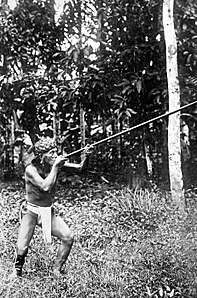 A Dayak man using a blowgun, Dutch East Indies, circa 1920
A Dayak man using a blowgun, Dutch East Indies, circa 1920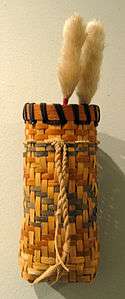 Rivercane quiver with blowgun darts, fletched with bull thistle
Rivercane quiver with blowgun darts, fletched with bull thistle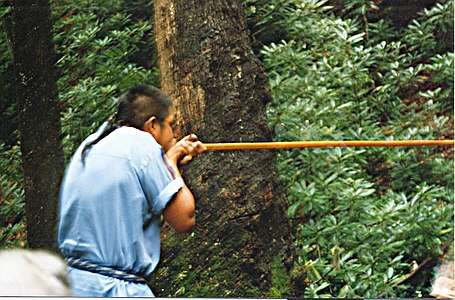
.jpg) An Achuar man with a blowgun, Ecuador
An Achuar man with a blowgun, Ecuador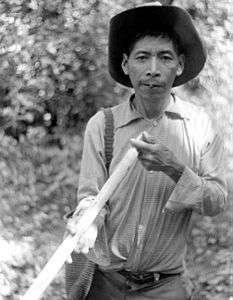
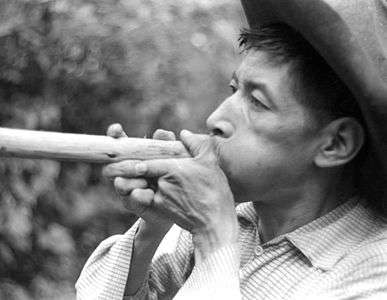 A Jakaltek Maya hunter aims at the eye of his target and then blows a clay pellet towards it.
A Jakaltek Maya hunter aims at the eye of his target and then blows a clay pellet towards it. Illustration c. 1480 of Medieval Europeans using a blowgun to hunt birds.
Illustration c. 1480 of Medieval Europeans using a blowgun to hunt birds.
Materials
Darts are typically made of hardwoods to prevent cracking, although bamboo skewers can be used informally. The dart's fletch can be made of many materials, such as down, feather tips, and animal fur. Modern materials, such as aluminium or carbon-reinforced plastic, are also used.
In Japan, the competition darts are made of cone shaped cellophane plastic rolled into a cone (Fukiya), topped with a non-pointed brass brad. The Japan Sports Fukiya Association JSFA has privatized the sport, and all materials must be purchased from them. International Fukiya Association IFA chairman H.Higuchi promotes worldwise blowgun rule cooperating with other countries.
In other nations, the modified piano wire is used to make the 0.40 in (10 mm) cal and 0.50 in (13 mm) cal darts, with certain manufacturers making specialty darts for odd sized or larger caliber barrels (0.35 in [9 mm] cal, 0.625 in [16 mm] cal, 0.68 in [17 mm] cal, and 0.75 in [19 mm] cal).
Use of home-made darts in the larger sizes, or for hunting is common, utilizing bamboo skewers (3 and 6 mm or 1⁄8 and 1⁄4 in diameter), wire coat hangers, and even nails, or knitting needles.
Specifications
As a primitive weapon, there are no set dimension for a blowgun's length and diameter. However, generally there are several sizes:
- Fukidake — diameter is 13 mm (0.51 in) cal in Japan. Tournament length is 120 cm (47 in), but for practice one can use a 50 cm (20 in) tube. No mouthpiece is used; users wrap their lips around the tube. International versions can be slightly more flexible, allowing a tube of 122 cm (4 ft) and 13 mm (0.50 in) cal under IFA rules. Darts consist of a paper cone 20 cm (8 in) long, weighing 0.8 g (3⁄100 oz).
- Cherokee – made of river cane,[6] 2 to 3 m (6 to 9 ft). Dart is 15 to 56 cm (6 to 22 in) long and made of locustwood or other available hardwoods such as oak, ash, maple, walnut, etc., fletched with bull thistle down or rabbit fur, that provides an air seal.[7]
- Jakaltek wooden blowgun averages 1 m (3 ft) long with a sight placed 30 cm (12 in) from the end. Clay pellets are the most common type of ammunition and clay is sometimes added under the sight when the diameter of the blowgun is too thin for more stability and a better aim.
- Modern (US/EU) — typically has a diameter of 0.40 in (10 mm) cal, however, both the 0.50 in (13 mm) cal and 0.625 in (16 mm) cal are admitted for competitive shooting, with restrictions on barrel length and darts dimensions/weight; with varying lengths having distance restrictions imposed. Bell-shaped mouthpiece. Standard length limited to 121 cm (48 in) in IFA sanctioned competition.
- Paintball marker — made to be identical to the size of a 0.68 in (17 mm) cal paintball.
Legality
A law was passed in Guatemala in the 1930s outlawing the use of the blowgun in an effort to protect small game. It was difficult to enforce in rural areas, but was one of the reasons for the decline of blowgun use in Guatemala.[8]
In the United Kingdom under the Criminal Justice Act 1988, and in Australia, the blowgun is categorized as an offensive weapon, and as such it is illegal to manufacture, sell or hire or offer for sale or hire, expose or have in one's possession for the purpose of sale or hire, or lend or give to any other person. Antique blowguns are, however, exempt.[9]
In Canada, the blowgun is classified as a prohibited weapon and is defined as any device that "being a tube or pipe designed for the purpose of shooting arrows or darts by the breath".[10] Any imported blowgun must be deactivated by either drilling a hole or by blocking it.
In the Republic of Ireland, blowpipes (blow guns) are classified as illegal offensive weapons.[11][12]
In the US State of California, blowguns are illegal.[13] They are also illegal in Massachusetts and the District of Columbia, but are legal elsewhere. There is currently no age requirement for using a blowgun.[14]
Poisoned darts
Shooting darts with a blowgun is an extremely stealthy, and even lethal, hunting technique if the darts are poisoned with plant extracts or animal secretions. In Guyana, Suriname, French Guiana, some isolated areas in South America, and in the Amazon and Orinoco basins, blowgun hunters impregnate the tips of their darts with curare. The explorer Joseph Gumilla first mentioned the use of this poison. In ancient literature, it's also referred to as uiraêry, uirary, uraré, woorara, and wourali.
The Ticuas, an ethnic group from Brazil, Columbia, and Peru, produce a type of curare called Ticuna. This poison acts quickly on the prey, killing birds like the toucan in a matter of three to four minutes and small monkeys in about eight to ten minutes.
In the Orinoco basin,[15] the blowgun and curare are used by: the Hoti, who make blowguns that are unique in their components; the Panare, who obtain blowguns from the Hoti; the Huottuja, or Piaroa, who get their blowguns from the Yekuana or Maquiritares; the Maquiritare, who get their curare from the Piaroa; and the Pemones, who also get their blowguns from the Yekuana or Maquiritares, though they make their own curare.
In the upper Rio Negro basin,[16] the combination of blowguns and poisoned darts is used by the Curripacos, or Banivas, who make their own blowguns using technology and materials different, in part, from those of the ethnic groups of the Orinoco. They also produce their own curare. Their ancestors, the Waodani, used a match known as kakapa along with the curare to impregnate the darts of their blowpipes.
The Piaroa are known for making curare to impregnate the darts of their blowguns. They produce it beginning with extracts of different species of plants from the Strychnos genus[17]- mainly maracure (Strychnos crevauxii)- mixed with kraraguero sap to increase the adhesion of the poison. An animal hit by a dart poisoned using the Piaroa recipe usually dies within fifteen minutes, depending on its body mass.
The Orang Asli of Peninsular Malaysia use the concentrated sap of Antiaris toxicaria (Malay : ipoh) to coat the point of their darts.[18]
See also
- Fukiya, Japanese blowgun
- Loire-style blowgun (French page)
References
- Carol Ventura. "The Jakaltek Maya Blowgun in Mythological and Historical Context", in Ancient Mesoamerica 14.2: 257–268, 2003.
- Cherokee, Blowgun, Bibliography. 2011. Contains a brief bibliography and article on the subject of blowguns.
- Health, Physical Education, Recreation a, and Hilliard, K. An instructor's guide to traditional Native American games of the Eastern Band of the Cherokee: grades 5-8. Middle Tennessee State University, 2014. Abstract: The purpose for this study was to develop a guide for instructors to use in understanding and teaching traditional games of the Eastern Band of the Cherokee. This guide is intended not only to provide an educational resource for instructors to use in teaching how to play traditional Eastern Band of the Cherokee games, but also as a resource to utilize in passing on historical and traditional information about each game. In creating this study the researcher identified two major topics to be reviewed: (1) Historical information relating to Native American culture with an emphasis on the Eastern Band of the Cherokee and traditional games of the Eastern Band (to provide a historical background of each game, including traditional purposes, how each game was played, traditional equipment, and other beneficial information for instructors and students). (2) Curriculum development information (to guide the researcher in developing the components and format for the instructor's guide). After reviewing the historical information available through interviews and literature, three categories of Eastern Band of the Cherokee games were found. These categories include games of skill and dexterity; games of amusement; and games of chance. Within the games of skill and dexterity category ten traditional Eastern Band of the Cherokee games were noted: arrow/dart throwing, tipping, and tossing games; blowgun games; chunkey; cornstalk shooting; a hunting game; kickball; marbles; a running game; stickball; and tug-of-war. Within the games of amusement category only one traditional Eastern Band of the Cherokee game was noted, a string game called Crow's Feet. Within the games of chance category there was also only one traditional Eastern Band of the Cherokee game found, a basket dice tossing game called Jacksnap. After reviewing the curriculum development literature, the Tennessee Instructional Model (1984) was selected for the overall design of the instructor's guide, with the added features of photographs of traditional equipment, when available, and lead-up activities which teach the skills necessary to play each game. By combining the Native American historical information and curriculum development information the instructor's guide was created, which includes an introduction to the Eastern Band of the Cherokee people and detailed lesson plans for each traditional game. The guidebook was constructed for the developmental characteristics of students in the fifth through the eighth grade. It is hoped that this guidebook will serve as a tool for instructors to use in keeping alive the history and traditions of the Eastern Band of the Cherokee games.
- Ruehl, Ron, and Lawson S. Warren. Hayes Lossiah: Cherokee Blowgun Maker. Raleigh, N.C.: N.C. Dept. of Cultural Resources, 1985. Summary: This program, set during the Cherokee fall festival in North Carolina, highlights the work of Hayes Lossiah, Cherokee craftsman and blowgun maker. Lossiah demonstrates the construction of a traditional Cherokee blowgun.
- Smith, Jim "Crow". 2017. "The Modern Blowgun". The Backwoodsman "The magazine for the twentieth century frontiersman specializing in trapping, woodslore, survival, gardening, muzzleloading & homesteading". Volume 38. September/October 2017. Pages 58–60.
- Oosahwee-Voss, Eric. River Cane: Its Ecological and Cultural Perspectives in Oklahoma Cherokee Culture. 2012.
- "Cherokee Games." Archived January 15, 2010, at the Wayback Machine Cherokee Heritage Center. (retrieved 19 Dec 2009)
- Edwin Shook. Blowguns in Guatemala. In Notes of Middle American Archaeology and Ethnology, III, no. 67, pp. 37-43. AMS Press, New York, 1946.
- Statutory Instrument 1988 No. 2019 The Criminal Justice Act 1988 (Offensive Weapons) Order 1988 (Coming into force 18 January 1989)
- Department of Justice Canada (1998-12-01). "Part 3. Section 12.". Regulations Prescribing Certain Firearms and other Weapons, Components and Parts of Weapons, Accessories, Cartridge Magazines, Ammunition and Projectiles as Prohibited or Restricted (SOR/98-462). Retrieved 2007-05-29.
- http://www.justice.ie/en/JELR/Pages/FAQ
- http://www.irishstatutebook.ie/eli/1991/si/66/made/en/print
- CA Penal Code §20010 Archived 2016-03-07 at the Wayback Machine California Legislative Information (retrieved 01 Feb 2016)
- "Legal and Safety Notices." United States Blowgun Association. (retrieved 19 Dec 2009)
- Jett, Stephen (1991). "Further Information on the Geography of the Blowgun and Its Implications for Early Transoceanic Contacts". Annals of the Association of American Geographers. 81 (1): 89–102. doi:10.1111/j.1467-8306.1991.tb01681.x – via JSTOR Journals.
- Yde, Jens (1948). "The Regional Distribution of South American Blowgun Types". Journal de la Société des Américanistes. 37: 275–317. doi:10.3406/jsa.1948.2372.
- Duke, James (1994). Amazonian Ethnobotanical Dictionary. Boca Raton: CRC Press.
- Endicott, Kirk M. (2008). The headman was a woman : the gender egalitarian Batek of Malaysia. Endicott, Karen Lampell. Long Grove, Ill.: Waveland Press. ISBN 9781577665267. OCLC 166372312.
Further reading
- Speck, Frank G. "The Cane BlowGun in Catawba and Southeastern Ethnology" in American Anthropologist 40:2 (Apr.-Jun., 1938), pp. 198–204.
- Sustak, David. 2007. Fukiyado: The Way of the Sport Blowgun. 258 pp.
- Juan F. Marino, Sumpitan - Il Grande Libro della Cerbottana (le origini, la storia, la tecnica, lo sport), Edarc Edizioni, 2007 (only in Italian). 273 pp.
- Chisholm, Hugh, ed. (1911). . Encyclopædia Britannica (11th ed.). Cambridge University Press.
- Marinas, Amante P., Sr. 1999. "Pananandata Guide To Sport Blowguns." 110 pp.
External links
- The Blowgun Forum
- Lefora Blowgun Forum
- Deutscher Blasrohr Verein
- France Sarbacane Sport Amateur
- Deutscher Blasrohr Sport Club
- International Fukiyado Association
- Japan Sports Fukiya Association
- United States Blowgun Association
- Cherokee blowgun
- Hunting by more natural methods from The Smoky Mountain News